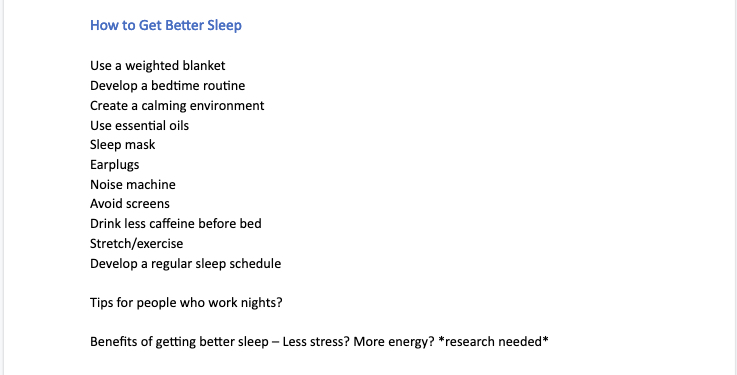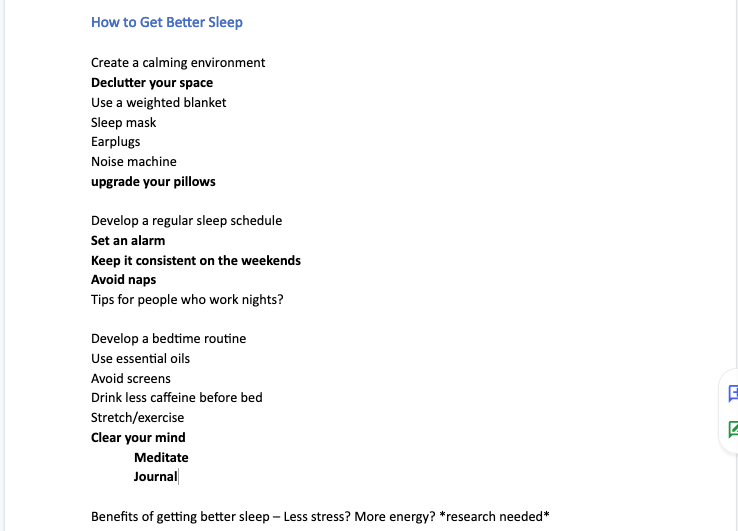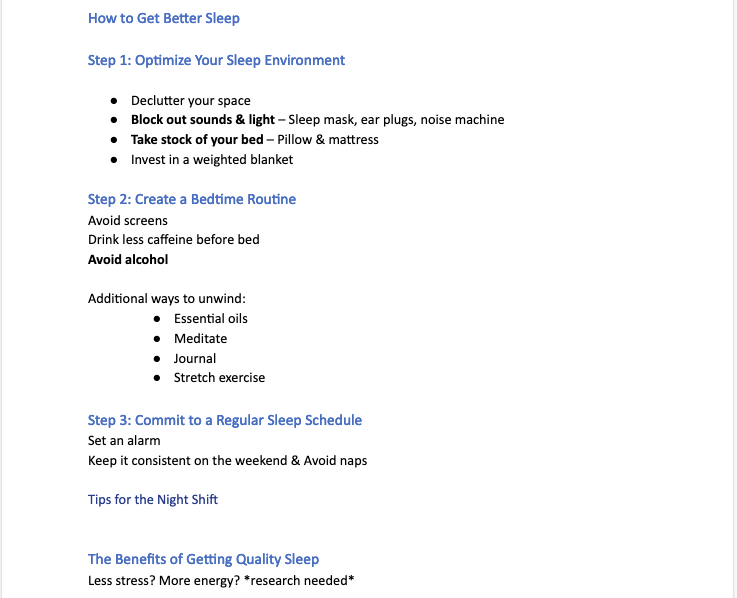Written by Rebecca van Laer
January 7th, 2022
Copycat's Anatomy #6 | Outlining for Copywriters

At Copycat, we’re always in the process of creating new professional development resources for working and aspiring copywriters. The below blog post is adapted from our in-house manual on all things copy-related, Copycat’s Anatomy.
Outlining for Copywriters
If you’ve never used an outline before—well, congratulations! You’ve gotten this far with copywriting, and you’re clearly doing something right when it comes to organizing your thoughts and putting words on the page.
For most of us mortals, outlines are a necessary step of the writing process, especially when approaching challenging prompts and unfamiliar topics.
Here, we’ll provide a step-by-step guide for using outlines to your advantage, as well as a list of tips and tricks to streamline your writing process.
Step 1: Understand Your Assignment
Before you dive into the outline process, it’s important to double-check that you understand the assignment.
You might’ve learned this in English class—no matter how well-organized and insightful your essay on Hamlet, it’s all for nought if the assignment was to write on an adaptation of a Shakespeare text.
Take a look at your article’s title, H1, meta description, and the client’s website to understand three things about the article:
- The purpose of the article. What should readers learn?
- The context of the article. Who is the intended audience? What do they already know?
- Your client’s thesis on the topic. Do they have a stake in how you write the piece?
This information can provide a jumping-off point for brainstorming.
Let’s take a look at a few potential example articles:
- X Benefits of Using a Virtual Assistant (for an Elite VA Staffing Company) – Your purpose is to provide a listicle listing the numbered benefits of using a virtual assistant. Based on the title, the article is targeted at people already interested in using a VA. Since your client is a VA company, their thesis is that it’s great to use a VA, and you should probably base the article around their value propositions.
- How to Get Better Sleep (for a Weighted Blanket Company) – Your purpose is to provide a How-to guide or listicle that will help people sleep more effectively. While you will want to incorporate a weighted blanket, writing too much about this particular product will not achieve that purpose. The client thesis is that sleep is great, and a weighted blanket helps you get it.
Step 2: Brainstorm & Research
Outlining and brainstorming can go hand in hand. Before you even start researching, try brainstorming in the form of a rough outline.
At Copycat, we advocate for outlining in progressive stages.
Have you ever created a supercalifragilisticexpialidocious outline to end all outlines, so long that it got you 60% of the way to your final word count?
How much of that outline did you actually end up filling in?
We thought so.
Rather than planning out the entire article in advance, consider aiming to outline one-half or one-third of the article.
Take a look at our example brainstorming for the weighted blanket article:

Note that some sections have a question mark or are marked “research needed.” You may not ultimately end up writing an article that covers every part of your outline.
As you begin to write, you’ll see how much research is actually required to reach your target word count. You’ll also start to spark new ideas that you can add to the outline.
Step 3: Group Related Ideas
No matter the genre of your article, grouping related concepts together can help you avoid repetition and create seamless transitions between ideas.
Let’s take a look at an example.
If you’re writing a listicle on “X” benefits of using a virtual assistant, how do you decide on a number? If the article is 800 words, you could theoretically write on three…or 30.
There will be a noticeable difference between the way these two articles read.
- Choosing to run through 30 benefits will result in an article that feels choppy. You won’t be able to provide a depth of information for any single item (and some may get no more than a sentence).
- If you group related concepts together, you can collapse several benefits like “create more content,” “communicate more effectively,” and “generate leads” under a single umbrella: “You can delegate tasks to your VA.” This umbrella heading will feel more broadly applicable for all kinds of businesses regardless of their specific needs.
Once you’ve brainstormed, look for ways to relate your ideas to each other.
Below, take a look at the evolving outline for “How to Get Better Sleep” (with new brainstorming added in bold):

Note that the writer was able to generate new ideas as they grouped their existing brainstorming into rough categories. With so many potential tips and steps for better sleep, they may no longer need to include a section on “benefits of getting better sleep.”
Step 4: Order Your Ideas
Once you’ve grouped related concepts, decide how to order them.
In a previous blog post, we discussed why it’s always important to answer the topic immediately in your copywriting.
In addition, follow these principles to order your ideas:
- Avoid unnecessary background – In a listicle on the benefits of VAs, resist the temptation to include a background section defining a virtual assistant before benefit #1. If you think the reader needs definitions, background, or history, try to include it in the introduction (or throughout the article where appropriate).
- Organize by relevance – Place sections directly related to the article at the top of your outline. If you need to include less relevant information to achieve your target word count, try to pivot to it towards the end of the article.
- Consider the progression – In a how-to article, steps need to be presented in the logical order. But the same is often true in a listicle! For example, in your article on VA benefits, you would want to list “You’ll Save Money” before “With Savings, You Can Scale.” No matter your article genre, it’s always important to present information in a logical order that avoids repetition.
Next, we’ll take a look at the re-ordered outline for the sleep guide:

The broad umbrella categories have been reordered into three steps, progressing from a one-time action to a long-term commitment.
Notice how sleep masks, ear-plugs, and noise machines have all been grouped together under a single step. In contrast, the brand’s product—a weighted blanket—stands out in its own bullet point.
Finally, note that the writer has still not built out the final part of their outline. They’re outlining in progressive stages, and will only begin that research after they’ve drafted the copy for Steps 1-3.
Step 5: Elevate Your Headings
Once you’ve completed a first draft of your article, go back through your headings and check for the following:
- Clarity – Can the reader skim your headings to get a sense of what the article covers? Does each heading correspond with the information beneath it?
- Parallelism – In an ideal world, your headings all take the same syntactic form (i.e., commands, verb phrases, nouns, etc.). While you sometimes need to mix-and-match due to the client’s outline or the demands of the topic, strive for parallelism. Beyond syntax, be aware that in How-tos and Listicles, steps or numbers should appear as either H2 or H3 headings–not both.
- Creativity – Parallel headings shouldn’t be repetitive. Vary your word choice, and look for opportunities to spice up your headlines in line with the voice of the brand you’re writing for.
Tips and Tricks for Outlining
With these five steps, you’ll be on your way to writing well-organized articles that provide value to readers and brands.
We’ve got just a few more quick tips for leveraging outlines to your advantage:
- Fill in your outline as you research. Found a great definition you want to use or rephrase? Plop it into the outline and highlight it in yellow (to remind yourself not to plagiarize). Realize there’s a definition or question you might want to explore more in-depth? Add it as an H3.
- Reverse outline to check for logic and redundancies. Reading through your H2s and H3s should tell a progressive story. Look at them from a birds-eye view after completing your first draft of the article. If you notice that two are actually on the same topic, there may be an opportunity to combine the sections. If there’s a definition in the penultimate section that would actually clarify the entire article, it might work better as your first heading after the intro.
- Identify credible sources while you outline. Perhaps you’ve found the information you’re looking for, but it’s on a competitor’s site (or it’s an otherwise low-quality source). See if you can’t find similar information through Google Scholar, or through a reputable website. Try googling the exact information with known databases in the industry, like “NCBI,” “.gov,” “Pubmed,” “WSJ,” etc. Utilizing these sources may even offer additional ideas for your outline that you wouldn’t consider otherwise.
Build the Scaffolding for Successful Articles with Copycat
Copywriting is an evolving industry, and as the competition grows to include both content from copy mills and AI-generated text, aspiring and experienced copywriters alike need to develop the skills to write logical, lyrical copy while maximizing their speed.
An efficient outlining process can help you reliably generate quality articles while minimizing the time you spend on your self-edit.
Want more tips and tricks of the trade? Get in touch with hr@copycatcopywriters.com!
Sources:
Purdue OWL. How to Outline. https://owl.purdue.edu/owl/general_writing/the_writing_process/developing_an_outline/how_to_outline.html